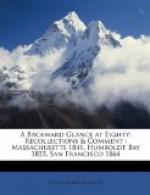In the present instance we alight from the car when it reaches Montgomery Street, at the Occidental Hotel, new and attractive, well managed by a New Yorker named Leland and especially patronized by army people. We rest briefly and start out for a preliminary survey. Three blocks to the south we reach Market Street and gaze upon the outer edge of the bustling city. Across the magnificently wide but rude and unfinished street, at the immediate right, where the Palace Hotel is to stand, we see St. Patrick’s Church and an Orphan Asylum. A little beyond, at the corner of Third Street, is a huge hill of sand covering the present site of the Glaus Spreckels Building, upon which a steam-paddy is at work loading flat steam cars that run Mission-ward. The lot now occupied by the Emporium is the site of a large Catholic school. At our left, stretching to the bay are coal-yards, foundries, planing-mills, box-factories, and the like. It will be years before business crosses Market Street. Happy Valley and Pleasant Valley, beyond, are well covered by inexpensive residences. The North Beach and South Park car line connects the fine residence district on and around Rincon Hill with the fine stretches of northern Stockton Street and the environs of Telegraph Hill. At the time I picture, no street-cars ran below Montgomery, on Market Street; traffic did not warrant it. It was a boundary rather than a thoroughfare. It was destined to be one of the world’s noted streets, but at this time the city’s life pulsed through Montgomery Street, to which we will now return.
Turning from the apparent jumping-off place we cross to the “dollar side” and join the promenaders who pass in review or pause to gaze at the shop windows. Montgomery Street has been pre-eminent since the early days and is now at its height. For a long time Clay Street harbored the leading dry-goods stores, like the City of Paris, but all are struggling for place in Montgomery. Here every business is represented—Beach, Roman, and Bancroft, the leading booksellers; Barrett & Sherwood, Tucker, and Andrews, jewelers; Donohoe, Kelly & Co., John Sime, and Hickox & Spear, bankers; and numerous dealers in carpets, furniture, hats, French shoes, optical goods, etc. Of course Barry & Patten’s was not the only saloon. Passing along we are almost sure to see some of the characters of the day—certainly Emperor Norton and Freddie Coombs (a reincarnated Franklin), probably Colonel Stevenson, with his Punch-like countenance, towering Isaac Friedlander, the poor rich Michael Reese, handsome Hall McAllister, and aristocratic Ogden Hoffman. Should the fire-bell ring we will see Knickerbocker No. Five in action, with Chief Scannell and “Bummer” and “Lazarus,” and perhaps Lillie Hitchcock. When we reach Washington Street we cross to make a call at the Bank Exchange in the Montgomery Block, the largest structure on the street. The “Exchange” is merely a popular saloon, but it boasts ten billiard tables and back of the bar hangs the famous picture of “Samson and Delilah.”




